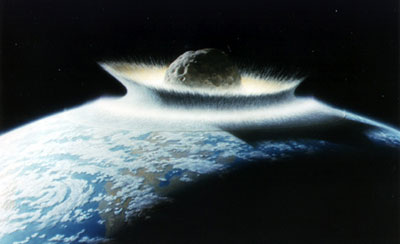Revising the Torino Scaleby Tom Hill
|
| The rock was upgraded from a 2 to a 4 on the scale simply because it had passed the easily recognizable, but essentially arbitrary, threshold of a one-percent chance of impacting the planet. |
The Palermo Scale is a more useful tool based on mathematical comparisons between the threat posed by the impactor and the background threat from similar-sized objects during the period of time in question, but it also rose to unprecedented levels for 2004 MN4 as new tracking data came in. Those who came up with the Palermo Scale recommend against its use for public ratings. According to a website describing the scale, values of zero or less do not merit concern, while values over zero merit concern. The Palermo rating for 2004 MN4 reached a maximum of approximately 2.
Simple scales are better for media reports to the public, which is what likely led to the (in my opinion) overly-simplified Torino Scale. The most complex scale in consistent use today is the Richter scale for measuring earthquakes, which still requires an occasional reminder that the scale is logarithmic: each whole number increase on the scale means a tenfold increase in the strength of the temblor.
Using the Richter scale as a top-end boundary for complexity of threat, but understanding that an asteroid impact threat rating has many more dimensions than a report of the strength of an already-occurred earthquake, we can set out to come up with something new. A rating scale with the simplicity approach of the Torino Scale and the objectiveness approach of the Palermo Scale would benefit all involved.
A proposed scale
One of the simplifications made in the Torino Scale was the inclusion of both the chance of an impact and the devastation potential of an impact on one axis. This division between “local effects”, “regional effects”, and “global effects” is what gives the scale a choppy feel. For the proposed scale, devastation potential and chance of impact are charted on separate axes. Initial thoughts for such a scale can be found here.
| One of the simplifications made in the Torino Scale was the inclusion of both the chance of an impact and the devastation potential of an impact on one axis. This division between “local effects”, “regional effects”, and “global effects” is what gives the scale a choppy feel. |
The devastation potential for an asteroid is assigned a letter based on the impactor’s energy delivery. While the scale is not calibrated at this point, it will be objective, proportional to the calculated kinetic energy of the rock or snowball. Large impactors such as the K-T dinosaur killer (to prevent the A-ha! emails, I acknowledge that it’s not known whether the K-T impactor was the true “killer” of the dinosaurs, or just another nail in their coffin, but let’s not get distracted by such things for right now) are rated the highest on the scale with a “J”, while comet tail dust, falling to Earth in a constant stream, is assigned an “A”. Other well-known impacts of the past are approximated on the scale.
The second, numerical, scale rating for all the samples is “9” because we know that they already impacted. For asteroids such as 2004 MN4, something more useful will be required. This scale must take into account the chance of an impact, the number of observations, and the amount of time that such observations were taken over, perhaps in terms of the object’s orbital period. A sample calculation is shown in the graphic. By describing a relatively straightforward formula for such a calculation, and weighting each portion appropriately, an asteroid with a 30% chance of hitting the Earth based on 6 observations taking place over 2 days will not cause a press release about a potential impactor with the caveats seen over the holidays of 2004. It is also proposed that any impactor cannot receive the highest ranking of “9” unless it has already passed it’s last known trajectory-altering body.
The colors on the chart are largely arbitrary at this point, and will be refined as the system is. A good dividing line for where action may be required is likely the June 2002 air-explosion asteroid that General Pete Worden talked about during a House Science Committee hearing in October of 2002, although our ability to predict future impacts of rocks 5-10 meters in size will be questionable for some time.
The one exception required for the rules specified above would be an impactor coming from deep space with an Earth zip code printed on it for direct delivery. In this situation, all tracking resources will have to be brought to bear on the offending rock and the best solution will have to be drawn with the data available. The exact rules for this situation are a discussion for another day.
Final thoughts
The current plot for 2004 MN4’s close approach to Earth on April 13th, 2029 makes it a potentially awesome show in the night sky somewhere on the globe. It may be worth traveling to see, but it’s not the civilization-altering event that was its potential late in December. To reiterate, I believe that everyone acted correctly given the situation that developed. Scientists who didn’t report according to the in-use scale would likely be accused of covering up an important story, while the sudden drop in threat level would have been a bigger deal had not current events on Earth been a much higher priority. Either way, we have a system for informing the public about NEO threats that could be improved, and here I’ve proposed one such improvement. Please take a look at the website. There’s a comment form at the bottom, and I guarantee I’ll read the inputs I receive. Perhaps, through Internet collaboration, we can come up with a better system for the future.
